Yesterday (Thursday 6th November 2025) we’ve already collated a few articles here relating to:
- a significant frequency spike:
- Peaking at 50.229Hz at 12:45:21.2 (NEM time);
- Which is outside of the Normal Operating Frequency Band.
- which appears to have been caused by some data glitch that added in ~1,700MW of ‘phantom demand’ in Victoria:
- Which NEMDE duly dispatched units to meet;
- Albeit overcooking frequency as a result.
Today, we have the advantage of ‘next day public’ data, so are able to peel some more layers of the onion.
No Market Notice?
Worth a short note at the start, however, to note that (unless I have missed something?) I did not see any Market Notice or other communication from AEMO about some form of ‘incorrect inputs’ scenario unfolding yesterday … it’s ~10:16 on Friday 7th November 2025 (so ~22 hours since the frequency excursion).
So I wonder whether:
- Investigations are on foot inside the AEMO and some communication will be forthcoming’; or
- Whether my hypothesis (above) is incorrect?
Interested to hear from the more knowledgable readers who might assist?
Taking a look at Dispatch Error
In this article, we’ll take a look at ‘Dispatch Error’ aggregated by Fuel Type across the NEM, in order to look at the general deviations from Target across the day. Again we use a pre-prepared trend in the ‘Trends Engine’ of ez2view, and have highlighted the relevant lunchtime period:
… but what is ‘Dispatch Error’?
Some early comments from readers has highlighted that some readers (especially those who don’t speak AEMO lingo so intimately) might misconstrue what we mean (and what the AEMO means) by the term ‘Dispatch Error’
… especially in an article speaking about a suspect data glitch!
So how is ‘Dispatch Error’ defined?
First thing to understand is that ‘Dispatch Error’ error is formally defined in AEMO’s Operating Procedures. It is calculated for each unit as follows:
Dispatch Error = Target (for the Dispatch Interval) – Final MW (for the same dispatch Interval)
So a layperson might think about this as a ‘Dispatch Deviation‘.
Note that:
1) It can be (and is) calculated for the Scheduled and Semi-Scheduled units (i.e. where they have Targets … notwithstanding that Target means a different thing for a Semi-Scheduled unit)
2) It can’t be calculated for a Non-Scheduled unit
3) And, as another corner case, notable that the Dispatch Error for a Negawatt unit is defined to be 0MW in the NEM Rules!
Why might a unit have a ‘Dispatch Error’?
There are essentially three different reasons why a unit might have a ‘Dispatch Error’:
1) There are some causes that are unambiguously good reasons:
(a) From September 2020, when it was re-implemented, many units (but unfortunately not all units) are configured to deliver Primary Frequency Response (PFR);
… these deviations away from Target are in relation to System Frequency needs, and are good things.
(b) There are a subset of registered DUIDs that are registered to provide (Contingency and/or Regulation) FCAS.
i. For those registered, they might bid to supply FCAS for a given Dispatch Interval;
ii. Depending on their bids (and bids from others), the NEMDE co-optimisation process might Enable them to provide FCAS.
iii. Again, delivery of frequency support in this way (as required by the commodity specifications) would also be a good thing.
2) But there are other reasons why Scheduled and Semi-Scheduled units might have Dispatch Error:
(a) For Scheduled units:
i. The instances of these deviations are much less frequent than for Semi-Scheduled units
ii. From time to time, the unit might have problems actually meeting its Target (due to technical, or other problems).
iii. After several dispatch intervals of ‘Dispatch Error’:, the AEMO might trigger a Non-Conformance notice.
(b) For Semi-Scheduled units:
i. The instance of ‘Dispatch Error’ is much more common than for Scheduled units;
ii. This happens because of the underlying variability of the energy source (i.e. the wind or the sun) and the inherent challenges in forecasting this 5 minutes ahead.
iii. But it also happens because of the much greater amount of leeway afforded to Semi-Scheduled units in meeting their Targets.
… which we have written about many times beforehand.
Is a positive (or negative) ‘Dispatch Error’ good, or bad?
Taking the thinking a step further:
1) Neither positive (or negative) Dispatch Error is innately wrong, or bad
2) Rather, it should be read:
(a) in conjunction with what the frequency needs at the time were … given most units have requirements to deliver PFR;
(b) and especially for units enabled for Regulation (or, in this case, Contingency) FCAS … neither of which are covered here.
Now, zooming in…
I’ve highlighted, on the chart above, the general dispatch intervals of interest – specifically the 6 x dispatch intervals shown in this ‘zoomed in’ view of the frequency excursion that was presented earlier here:
With respect to the ‘Dispatch Error’ aggregated by Fuel Type across the NEM in the chart above, we’ve extracted the data and present each of the dispatch intervals discretely below. Click on a chart in the table (or above) to open as a larger-resolution view in a separate tab.
So in the table below, we present ‘Dispatch Error’ side-by-side with a summary of the frequency in the dispatch interval, to help readers understand.
| Dispatch Interval | Frequency Performance … in this Dispatch Interval |
Dispatch Error … in this Dispatch Interval |
|---|---|---|
| 12:25
(NEM time) … belatedly adding this one in based on early reader suggestions |
The frequency performance is not shown in the chart above, but could be considered as ‘normal’
|
The Dispatch Error for each Fuel Type at 12:25 has been belatedly added in here: |
|
As noted in this earlier article from yesterday, the 12:25 dispatch interval was the last dispatch interval that appeared ‘normal’. |
||
| 12:30 | The 12:30 dispatch interval (i.e. ending 12:30) is just prior to the frequency starting to rise beyond the PFR deadband.
So you might read this as frequency being stable through this 5 minute period.
|
The Dispatch Error for each Fuel Type at 12:30 was as shown here: |
|
As noted in this earlier article from yesterday, the 12:30 dispatch interval is the dispatch interval where the ‘Notification’ widget alerts in ez2view first triggered: 1) in this case because of an (apparent, but presumably erroneous) increase in ‘Market Demand; of +646MW in the Victorian region. 2) We think that there was a glitch of ~500MW in here (and also compounded glitches in the next 2 dispatch intervals of about the same size In this case (interestingly) most fuel types sets are collectively under-performing by the end of the dispatch interval: 1) the scale of the numbers are not enormous: (a) Compared to what followed; (b) But still do add to ~500MW … coincidence or not?! 2) looking more closely at the frequency reading above for the 12:30 dispatch interval, we see that: (a) the frequency rose to the 50.05Hz level mid-way through the dispatch interval (b) and was pushed back down several times i. perhaps because of meeting resistance from PFR-delivering units that started to trigger at 50.05Hz ii. which might explain the collective under-performance in the chart for 12:30 above? |
||
| 12:35 | Within the 12:35 dispatch interval the frequency has been rising steeply.
Specifically: 1) It’s at ~12:30:34.4 that the frequency appears to break out from the PFR deadband 2) By 12:34:31.9 the frequency is at 50.15Hz (the upper bound of the NOFB), thereafter: (a) It appears to meet resistance from Contingency FCAS (b) but breaks free and climbs further.
|
The Dispatch Error for each Fuel Type at 12:35 was as shown here:
|
|
Note that the scale of the numbers here are considerably larger than the dispatch interval above. Collectively: 1) 5 of the 6 Fuel Types are each collectively under-performing … each of which will have helped to rein in frequency escalation to be at a slower rate 2) The other case (Hydro) was over-performing … but remember that this includes the effect of all the hydro units in Tasmania: (a) Now, whilst I have not unbundled to Hydro in the Mainland (b) And nor have a looked at what frequency (and Basslink) was doing at the time … generally we know that frequency is somewhat independent in Tasmania.
|
||
| 12:40 | Within the 12:40 dispatch interval the frequency:
1) has been (almost) fully outside the NOFB for the entire 5 minutes. 2) Is still climbing through this period. |
The Dispatch Error for each Fuel Type at 12:40 was as shown here:
|
|
Note that the under-performances of BESS, Coal and Large Solar has all increased … but Wind and Hydro have each changed direction of which way they are pulling frequency (albeit both are very small). As noted on the image, with respect to Large Solar: The under-performance of Solar Units collectively has grown from 201MW (prior dispatch interval) to 420MW (this dispatch interval, which will have helped. The same questions remain: Q1) to what extent was this due to the operation of PFR on these units? Q2) or to what extent was this just due to other (coincidental) factors that were clearly beneficial in this instance? (a) poor forecast accuracy of UIGF? (b) poor dispatch control? (c) other?
|
||
| 12:45 | Within the 12:45 dispatch interval the frequency:
1) has been fully outside the NOFB for the entire 5 minutes. 2) is continuing to climb
|
The Dispatch Error for each Fuel Type at 12:45 was as shown here:
|
|
Note that the under-performances of BESS, Coal and Large Solar has all continued to increase … which will all have helped to 1) Both BESS and Coal performance is tightly controlled (as they are Scheduled units), so we know that these beneficial contributions were intentional 2) But for Large Solar, it’s Semi-Scheduled, so there is again the same questions that apply here. Note also that Wind is now providing a reasonably sized beneficial effect on frequency, with Hydro very small whilst flipped other way. |
||
| 12:50 | The peak frequency (50.229Hz) is reached at 12:45:21.2, which is shortly after the start of this dispatch interval.
1) Thereafter, there’s a steady drop in frequency; 2) By ~12:47 it has dropped inside the NOFB for the first time in ~10 minutes. 3) By ~12:48:56.8 the frequency is within the PFR deadband again. |
The Dispatch Error for each Fuel Type at 12:50 was as shown here:
|
| Indeed, it’s probably not a coincidence that the timing of the peak in frequency is ~21 seconds into the dispatch interval, which:
1) is when most units will have received their Targets* for the 12:50 dispatch interval (a) at which time many units will have seen a markedly different trajectory, as a result of the ‘phantom demand’ having been removed from the ‘Market Demand’ figure for this dispatch interval. (b) (re *), remember this ‘(… first step into the complexities of) the Dispatch Interval in the Real World’ 2) these new Targets (for a marked reduction in supply) will have contributed, in a large way, to reining in the wayward frequency.
|
||
| 12:55 |
During this period, the frequency was mostly within the PFR deadband, though slightly above 50Hz. |
The Dispatch Error for each Fuel Type at 12:55 was as shown here: |
| In this case, we infer what we are seeing here is a return to ‘normal’ operations, in which:
1) The Semi-Scheduled (Solar and Wind) units operate ‘to the beat of their own drum’: (a) because of the underlying variability and also the manner in which Semi-Scheduled units are allowed to operate; (b) in this case delivering over-performance relative to Target … so acting to push frequency higher. 2) On the balancing side of the equation, the Scheduled units (especially the Battery Units, on this occasion) are doing what they can via PFR and Regulation FCAS to pull frequency back towards 50Hz. Note … 200MW variations are quite small, compared to what we are increasingly seeing. |
||
There’s more ‘next day public’ date that we can look at … but not in this article.
A reminder…
We’ll close off this article now, but probably worth drawing the parallel between the article ‘What happens, when Supply ≠ (real!) Demand’ from 10th October which was prepared:
- Following from my presentation at NEMdev 2025;
- But also as an input into some of the recommendations in the draft report from the Nelson Review panel.


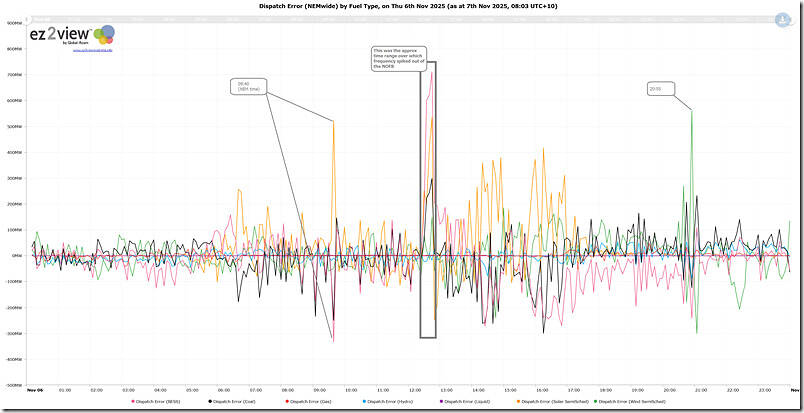

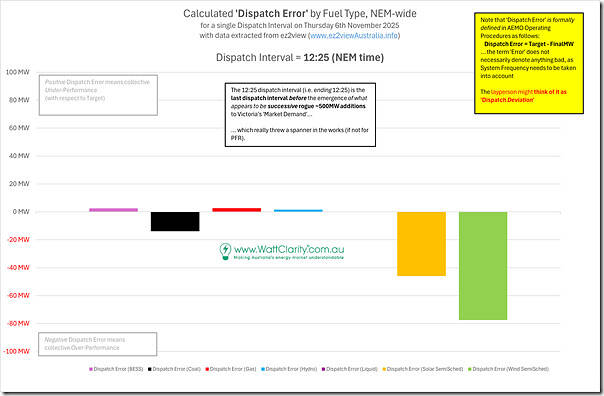
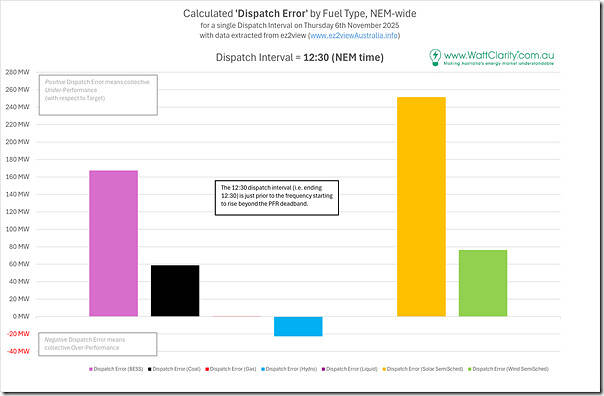

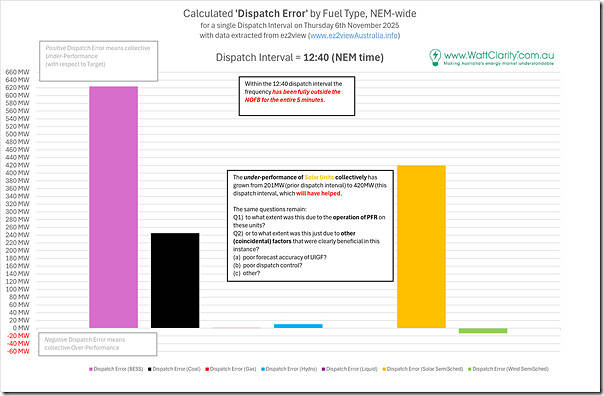
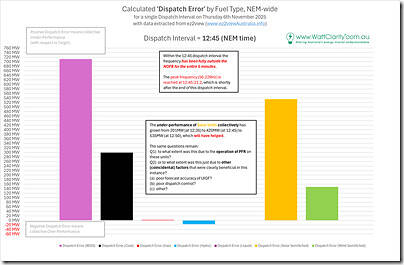
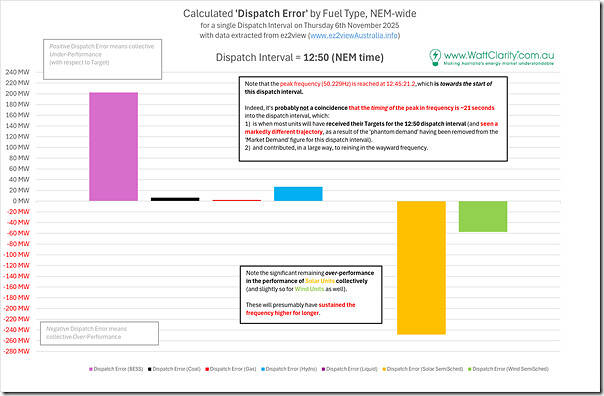
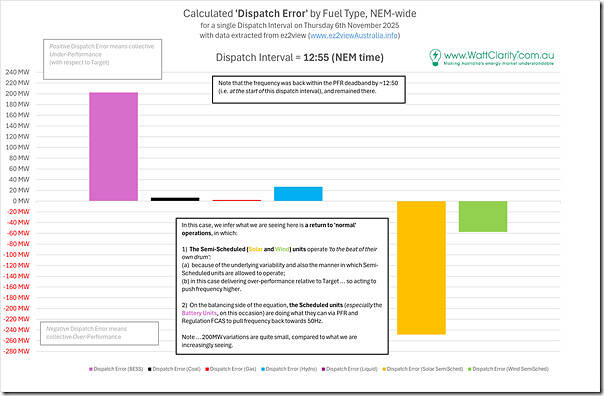

Be the first to comment on "A quick look at ‘Dispatch Error’ on Thursday 6th November 2025, in conjunction with the Frequency Spike"